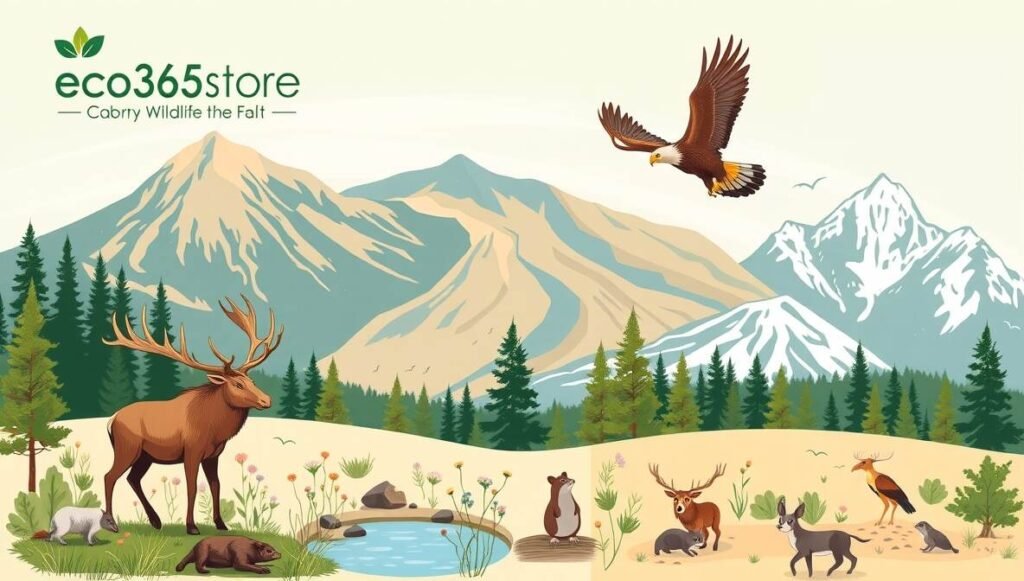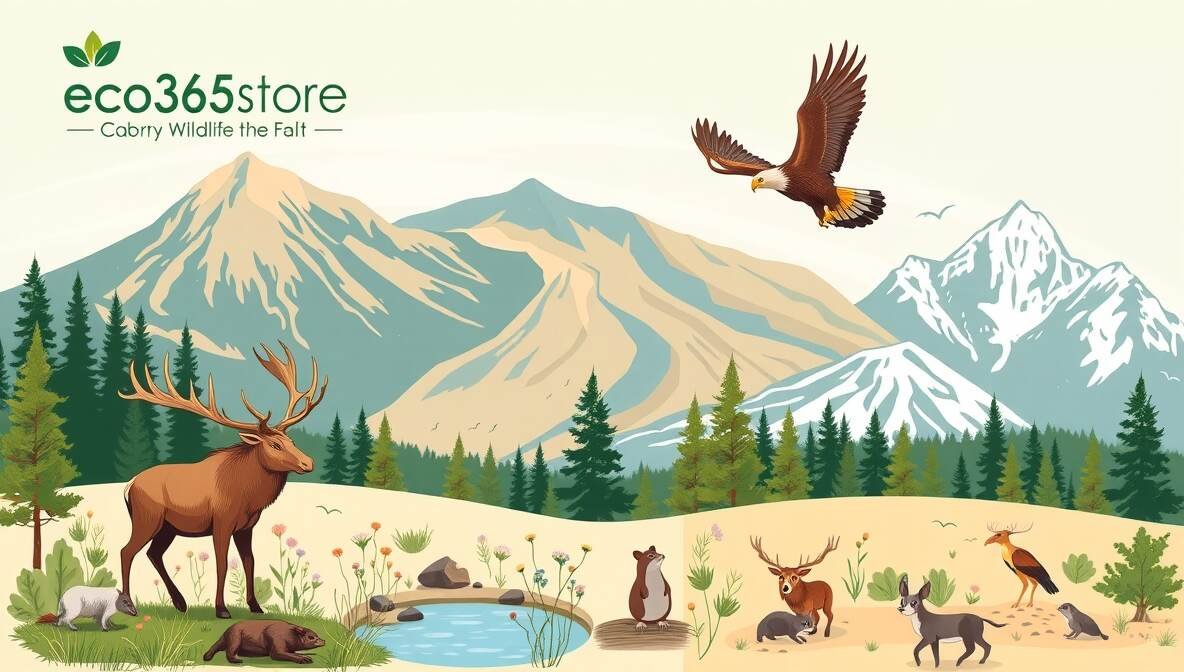Colorado, with its awe-inspiring mountains, expansive plains, and serene rivers, offers nature enthusiasts an unparalleled opportunity to connect with wildlife. Known as one of the best places to see wildlife in Colorado, this state boasts a dazzling array of ecosystems that are home to numerous species. From towering elk in Rocky Mountain National Park to majestic bald eagles soaring across the skies, Colorado’s wildlife is as diverse as its landscapes.
Whether you’re a local explorer, a wildlife photographer in Colorado, or someone planning a trip, this guide reveals the top spots, best times, and essential tips for enjoying the state’s incredible fauna.

Why Colorado Is the Best Place to See Wildlife
Colorado’s varied geography creates a uniquely diverse habitat for animals. The state features alpine tundra, lush forests, arid deserts, and grasslands, attracting species adapted to a range of environments. Protected areas like Rocky Mountain National Park and the San Luis Valley emphasize conservation, ensuring these creatures thrive in their natural habitats.
Notably, Colorado has invested heavily in wildlife restoration and preservation projects. The initiative to reintroduce the Canada lynx to the San Juan Mountains is a prime example of the state’s commitment to its ecological heritage. Additionally, the state’s extensive network of open spaces and wildlife refuges furthers its reputation as a leader in preserving biodiversity.
From observing large herds of bison on the plains to hearing the haunting bugle of an elk in autumn, Colorado’s wildlife experiences go unmatched.
Top Wildlife Spots in Colorado
1. Rocky Mountain National Park
Arguably the crown jewel of wildlife watching in Colorado, this park is famed for its alpine meadows and rugged peaks. Visitors frequently encounter elk, moose, and mule deer. Birds like Clark’s nutcracker and golden eagles are also prevalent. Drive the scenic Trail Ridge Road or hike through areas like Moraine Park for the best sightings.
2. San Luis Valley
A birdwatcher’s paradise, this vast valley is particularly known for its annual crane migration. Thousands of sandhill cranes gather here in spring and fall, creating an unforgettable spectacle. It is also home to pronghorn antelope and bighorn sheep.
3. Buffalo Peaks Wilderness Area
Located near Buena Vista, this lesser-known retreat is perfect for spotting mountain goats, marmots, and pika. The area’s windy mountain trails are ideal for quiet wildlife observation.
4. Boulder County Open Spaces
Closer to urban centers, Boulder’s open spaces host a surprising amount of wildlife, from red foxes to bald eagles. The Sawhill Ponds Nature Preserve is a hidden gem for beaver and birdwatching enthusiasts.
5. Pawnee National Grassland
Visit this expanse in eastern Colorado to witness prairie dogs, burrowing owls, and herds of bison. The region offers a quiet contrast to the grandiosity of the mountains, while still delivering outstanding wildlife experiences.
Best Time of Year to Spot Wildlife in Colorado
Here’s how wildlife activity changes with the seasons in Colorado:
- Spring (March–May): Elk and deer emerge from winter shelters. This is also prime time for sandhill crane migrations in the San Luis Valley.
- Summer (June–August): Ideal for hiking and spotting marmots, mountain goats, and wildflowers. Alpine tundra areas are particularly active.
- Fall (September–November): Elk mating season (rut) creates spectacular viewing opportunities in Rocky Mountain National Park. Migratory birds fill the skies.
- Winter (December–February): Snow-covered landscapes make it easier to track elusive mammals like bobcats and foxes. This is also a great time to spot bald eagles along riverbanks.
Late afternoons and early mornings maximize sightings when animals are most active.
Animals You Can Expect to See in Colorado
Colorado is home to a wide variety of species, including some rare and iconic names:
- Mammals: Black bears, mountain lions, elk, moose, and pronghorn.
- Birds: Bald eagles, greater sage-grouse, peregrine falcons, and white-tailed ptarmigans.
- Reptiles and Amphibians: Bullsnakes, tiger salamanders, and collared lizards.
- Fish: Colorado cutthroat trout, a prized catch for anglers.
- Prairie and High-Altitude Species: Prairie dogs, mountain goats, marmots, and bison.
This mix, spread across the state’s varied ecosystems, makes wildlife exploration both exciting and unpredictable!
Tips for Safe & Ethical Wildlife Viewing
Enjoy Colorado’s nature responsibly with these essential tips:
- Maintain Safe Distances: Stay at least 100 feet from most wildlife, and even farther from predators like bears.
- Stay Quiet: Loud noises may scare off animals or stress them unnecessarily. Use binoculars for a closer look.
- Follow Local Guidelines: Respect area-specific rules, especially in protected parks and during sensitive seasons like nesting or rutting.
- Avoid Feeding Wildlife: Feeding can disrupt natural behaviors, leading to dependency on humans.
- Pack Out Trash: Leaving waste behind can harm animals who might ingest it and disrupt the ecosystem.
Wildlife Photography Tips
Elevate your wildlife photography in Colorado with these actionable tips:
- Invest in a Long Lens: A 300mm lens or longer is ideal for capturing animals up close without intrusion.
- Play with Natural Light: The golden hours of sunrise and sunset create warm, stunning tones in photos.
- Use a Stable Setup: A monopod or compact tripod helps reduce motion blur.
- Know Your Subject: Understanding animal behavior can lead to better timings and compositions.
- Frame Wide Shots: Including the landscape such as mountains or meadows provides context and drama.
How to Get to Colorado’s Top Wildlife Destinations
Traveling within Colorado is simple with these options:
- By Air: Fly into Denver International Airport (DEN) or regional airports like Eagle County (EGE) or Aspen (ASE).
- By Car: Rent a car to access remote parks like Rocky Mountain National Park or Pawnee National Grasslands.
- Guided Tours: Joining wildlife-focused tours ensures guided, structured, and educational outings without logistical stress.
Affiliate Suggestion:
Organize all your travel essentials, including rental cars and guided expeditions, here [#].
Where to Stay Nearby
Stay close to the action with these excellent accommodations:
- Budget: Skyline Lodge & Cabins in Estes Park offers affordable stays near Rocky Mountain National Park.
- Mid-Range: The Historic Strater Hotel in Durango combines comfort and charm with access to mountain trails.
- Luxury: Devil’s Thumb Ranch near Winter Park provides high-end lodgings with an emphasis on eco-tourism.
Affiliate Suggestion:
Book your stay through this platform [#] for exclusive deals.
Nearby Attractions or Activities
Expand your experience with these additional adventures:
- Glenwood Hot Springs: Relax in natural thermal pools after a long day of wildlife watching.
- Garden of the Gods: A geological wonder near Colorado Springs with opportunities to spot peregrine falcons.
- Mount Evans Scenic Byway: Drive one of North America’s highest roads while spotting mountain goats and tundra wildlife.
Conclusion
Colorado’s natural beauty and rich biodiversity make it one of the best places to see wildlife. From the mighty Rockies to the serene grasslands, every corner offers unique adventures and countless animal encounters.
Don’t wait to explore! Plan your Colorado wildlife adventure today and create cherished memories immersed in one of nature’s most dynamic destinations.
FAQs
- What is the best time to see elk in Colorado?
Fall is ideal, particularly during the September-October rut season in Rocky Mountain National Park. - Are there guided tours for wildlife watching in Colorado?
Yes, many operators offer eco-friendly tours, especially in parks like Rocky Mountain and San Luis Valley. - Is wildlife watching safe?
Yes, as long as you respect safety guidelines, maintain a distance, and avoid provoking animals. - What should I pack for a wildlife trip?
Essentials include layered clothing, binoculars, a camera, sturdy footwear, and sunscreen. - Can you spot bears in Colorado?
Yes, black bears are commonly found in forested regions, especially during late summer and fall.

Anamika is a passionate writer for Eco365Store.com, specializing in topics that inspire a cleaner, greener world. With expertise in home cleaning, recycling, and eco-friendly solutions, she crafts engaging and informative articles that help readers adopt sustainable practices in their daily lives.

